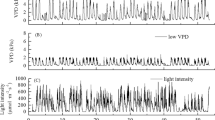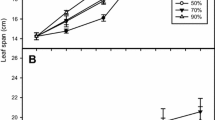Abstract
CO2 and water vapour exchange rates of four alpine herbs namely: Rheum emodi, R. moorcroftianum, Megacarpaea polyandra and Rumex nepalensis were studied under field conditions at 3600 m (natural habitat) and 550 m altitudes. The effect of light and temperature on CO2 and water vapour exchange was studied in the plants grown at lower altitude. In R. moorcroftianum and R. nepalensis, the average photosynthesis rates were found to be about three times higher at 550 m as compared to that under their natural habitat. However, in M. polyandra, the CO2 exchange rates were two times higher at 3600 m than at 550 m but in R. emodi, there were virtually no differences at the two altitudes. These results indicate the variations in the CO2 exchange rates are species specific. The change in growth altitude does not affect this process uniformly.
The transpiration rates in R. emodi and M. polyandra were found to be very high at 3600 m compared to 550 m and are attributed to overall higher stomatal conductance in plants of these species, grown at higher altitude. The mid-day closure of stomata and therefore, restriction of transpirational losses of water were observed in all the species at 550 m altitude. In addition to the effect of temperature and relative humidity, the data also indicate some endogenous rhythmic control of stomatal conductance.
The temperature optima for photosynthesis was close to 30°C in M. polyandra and around 20°C in the rest of the three species. High temperature and high light intensity, as well as low temperature and high light intensity, adversely affect the net rate of photosynthesis in these species.
Both light compensation point and dark respiration rate increased with increasing temperature.
The effect of light was more prominent on photosynthesis than the effect of temperature, however, on transpiration the effect of temperature was more prominent than the effect of light intensity.
No definite trends were found in stomatal conductance with respect to light and temperature. Generally, the stomatal conductance was highest at 20°C.
The study reveals that all these species can easily be cultivated at relatively lower altitudes. However, proper agronomical methodology will need to be developed for better yields.
Similar content being viewed by others
References
Billings WD and Mooney (1968) The ecology of arctic and alpine plants. Biol Rev 43: 481–529
Bjorkman O, Ludlow MM and Morrow PA (1972) Photosynthetic performance of two rainforest species in their native habitat and analysis of their gas exchange. Carnegie Inst Wash Yb 71/72: 94–102
Chabot BF and Chabot JF (1977) Effect of light and temperature on leaf anatomy and photosynthesis in Fragaria vesca. Oecologia (Berlin) 26: 363–377
Korner Ch (1982) CO2 exchange in alpine sedge Carex curvula as influenced by canopy structure, light and temperature. Oecologia (Berlin) 53: 98–104
Korner Ch and Cochrane PM (1985) Stomatal responses and water relations of Eucalyptus pauciflora in summer along an elevational gradient. Oecologia (Berlin) 66: 443–455
Korner Ch and Diemer M (1987) In situ photosynthetic responses to light, temperature and carbon dioxide in herbaceous plants from low and high altitude. Functional Ecology 1: 179–194
Mooney HA and Billings WD (1961) Comparative physiological ecology of arctic and alpine populations of Oxyria digyna. Ecol Monog 31: 1–29
Mooney HA and West M (1964) Photosynthetic acclimation of plants of diverse origin. Am J Bot 51: 825–827
Mooney HA, Wright RD and Strain BE (1964) The gas exchange capacity of plants in relation to vegetation zonation in the White Mountains of California. Am Midl Nat 72: 281–297
Moser W (1970) Okophysiologische untersuchungen an Nivalpflanzen. Mitteilungen der Ostalpin-Dinarischen. Geseiischaft fur Vegetationskunde 11: 121–134
Pearcy RW (1977) Acclimation of photosynthetic and respiratory carbon dioxide exchange to growth temperature in Atriplex lentiformis (Torr.) Wats. Plant Physiol 59: 795–799
Scott D and Billings WD (1964) Effect of environmental factors on standing crop and productivity of an alpine trundra. Ecol Monog 34: 243–270
Turner NC, Begg JE, Rawson HM, English SD and Heard AB (1978) Agronomic and physiological responses of soybean and sorghum crops to water deficits III. Components of leaf water potential, leaf conductance, CO2 photosynthesis and adaptation to water deficits. Aust J Plant Physiol 5: 179–194
Author information
Authors and Affiliations
Rights and permissions
About this article
Cite this article
Rawat, A.S., Purohit, A.N. CO2 and water vapour exchange in four alpine herbs at two altitudes and under varying light and temperature conditions. Photosynth Res 28, 99–108 (1991). https://doi.org/10.1007/BF00054123
Accepted:
Issue Date:
DOI: https://doi.org/10.1007/BF00054123




